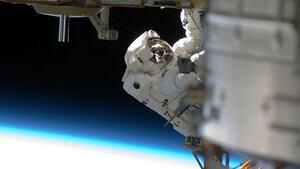There’s a lot of junk in space. Tens of thousands of pieces of it, circling the Earth at thousands of miles per hour. Each piece is an orbital bullet that can endanger satellites, manned capsules, and the International Space Station.
The European Space Agency is about to pull one of the bigger hunks of garbage from orbit. But there’s a problem: The same tech that could help make space cleaner might, in the long run, also make it more dangerous.
That’s because the ESA’s ClearSpace-1 orbital garbage truck, as well as other spacecraft like it, could double as a weapon.
Swiss startup ClearSpace designed the ClearSpace-1 vehicle to intercept a chunk of debris, latch onto it, and drag it back into Earth’s atmosphere where it can safely burn up. The ESA has scheduled the clean-up mission for 2025 and has even identified its target: a 265-pound piece of an old rocket orbiting 310 miles above Earth’s surface.
The 2025 mission will involve what ClearSpace CEO Luc Piguet called “non-cooperative capture.” That is to say, the targeted piece of debris wasn’t designed with an interface or any other system that might help a clean-up craft grab onto it.
As the first-ever orbital garbage-collection job, the ClearSpace mission “will address and solve critical technical problems,” Piguet told The Daily Beast.
In the future, rocket and satellite-builders could add interfaces to their hardware, making it easier for companies like ClearSpace to clean them up. “We hope that active debris removals will soon become a standard operation in space,” Piguet said.
Now imagine if a rogue state or some future high-tech terror group sent a craft similar to ClearSpace-1 to intercept and de-orbit, say, an active missile-warning satellite or even the space station. “There is of course a potential that certain regimes will find such technology abusively interesting,” Daniel Campbell, managing director of U.K. space firm Effective Space, told The Daily Beast back in early 2019.
The world’s space agencies seem to accept that risk. After all, the orbital-junk problem has gotten bad fast since the first space launch back in 1957—and it could get a lot worse in coming decades. Counting old, defunct satellites, parts of rockets, and the leftovers from military missile tests, there are at least 34,000 chunks of debris greater than 10 centimeters across, according to the ESA.
That number’s likely to grow, and quickly. The world’s spacefaring countries together launch more than a hundred large rockets every year. And as space tech gets smaller, the number of satellites each rocket can carry is growing.
In 2017 the Indian Space Research Organization lofted a record 104 tiny satellites atop a single rocket. Telecommunication companies are planning “mega-constellations” of small sats that could include thousands or even tens of thousands of tiny craft.
Most firms insist they can safely de-orbit 90 percent or more of the sats once they break down or run out of fuel. But that still leaves potentially hundreds of major pieces of debris from each mega-constellation. Earth’s orbit could get dirtier before it gets cleaner.
More and more rocket companies and space agencies are deciding it’s too dangerous to just leave all that junk in space. Some have begun looking for contractors to de-orbit the bigger pieces. “We expect the market for such missions to be considerable,” Holger Krag, head of the ESA’s Space Debris Office in Germany, told The Daily Beast.
Campbell’s Effective Space, as well as Russian firm RSC Energia, European company Airbus and Orbital ATK and Space Systems Loral in the United States, are all working on so-called “space tugs”—in essence, traveling spare rocket boosters—that, for a price, can attach themselves to failing satellites and give them life-extending shoves to higher orbits.
But Effective Space is also marketing its 800-pound space tug as a debris-removal vehicle. Instead of boosting an object upward, it would boost it downward. Space tugs are the likely foundation of the orbital garbage-collection industry.
That’s the same method that the world’s most dangerous space weaponry could use to attack the spacecraft of rival countries. Russia, China and the United States have all tested small, maneuverable “inspection” satellites that could double as attack craft. Maneuvering close to an enemy spacecraft, an inspection sat could grab onto and hurl its target into the atmosphere.
Weaponizable satellites are “the Pandora’s box of space operations,” James Oberg, a former NASA mission-controller who also advised U.S. Space Command, told The Daily Beast.
Even the mere suspicion that a country might turn its tugs into weapons could have serious consequences, MIT researchers Matthew Richards, Philip Springmann and Michelle McVey warned back in 2005.
“The potential for negative international reaction to a U.S. orbital-correction capability is one of the key challenges facing space-tug implementation,” the researchers wrote in a joint study. “What if space tugs are perceived as a space weapon and the U.S. government faces stiff international resistance?”
The same suspicion could apply to the ESA or other agencies that send tugs into space for debris clean-up. Every garbage-collection mission could look like a potential attack.
To be fair, that’s not a new problem. “All technology can be used for dual purposes,” Krag pointed out. He told The Daily Beast that ClearSpace-1 “is too complex” for some rogue state or terror group to deploy.
But what happens as the orbital clean-up industry grows and starts launching space tugs by the dozens or hundreds? What happens when tech like ClearSpace’s becomes cheap and common? The same spacecraft that work to declutter Earth’s orbit could, with the flip of a few switches, transform into weapons.






